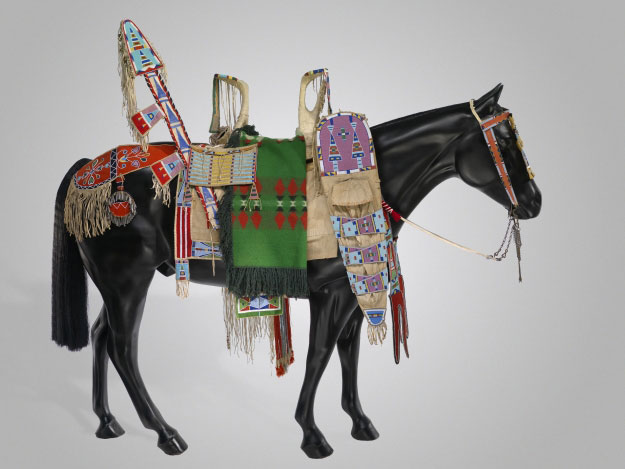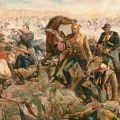“A Song for the Horse Nation” gallops into Washington
Image: Detail from Lakota Horse Mask, 2008, by Jim Yellowhawk (Cheyenne River Lakota). Photo by Ernest Amoroso
The Smithsonian’s National Museum of the American Indian in Washington, D.C., will open a major exhibition this fall that explores one of the greatest sagas of human contact with the animal world—American Indians and horses.
Through an array of 122 historic objects, artwork, photographs, songs and personal accounts, “A Song for the Horse Nation” tells the epic story of how the return of horses to the Americas by Christopher Columbus changed everything for Indians—from the way they travelled, hunted and waged war to how they celebrated generosity, exhibited bravery and conducted ceremonies. It shows how horse trading among tribes was the conduit for the extensive spread of mustangs in the Plains and Plateau regions of the United States, as well as how horses became the inspiration for new artistic expressions and rich traditions that continue to this day.
“When American Indians encountered horses—which some tribes call the Horse Nation—they found an ally, inspiring and useful in times of peace, and intrepid in times of war,” said Kevin Gover (Pawnee), director of the museum. “The exhibition shows how these majestic creatures came to represent courage and freedom to many tribes across North America.”
The critically acclaimed exhibition, first shown at the museum’s George Gustav Heye Center in New York (Nov. 14, 2009-July 10, 2011), doubles its exhibition space at the flagship museum on the National Mall to 9,500 square feet and includes 15 major additional objects. Among them is a 19th-century, 16-foot-tall, 38-foot-circumference Lakota tipi, in which 110 hand-painted horses, some with riders, all at a full gallop, cover the entire surface in rich reds, turquoise blues and golds as vivid and fresh as the day they were created. These battle and horse-raiding scenes proclaim the heroic deeds of the warrior who once lived in the tipi.
Life-size model horses, one pulling a 19th-century Cheyenne travois (a frame used to drag heavy loads over land), and another tacked in a dazzling display of fully beaded traditional Apsáalooke (Crow) regalia used in parades today, will also be on display. Other highlights include rifles belonging to celebrated mounted warriors Geronimo (Chiricahua Apache), Chief Joseph (Nez Perce) and Chief Rain-in-the-Face (Hunkpapa Lakota) and the famous ceremonial dance stick (ca. 1890) of No Two Horns (Hunkpapa Lakota), which he created to honor his well-loved horse that died at the Battle of the Little Big Horn.
Visitors will discover daring feats of bravery such as “counting coup,” in which a warrior would gallop astride an enemy and touch him with his hand. They will learn that raiding an enemy’s horses is a proud tradition that survived even into 20th-century warfare—during World War II, Joseph Medicine Crow, Apsáalooke (Crow), now in his 90s, liberated horses from the Nazi SS in the finest tradition of a Plains Indian warrior. He received the Presidential Medal of Freedom, the nation’s highest civilian honor, from President Barack Obama Aug. 12, 2009.
The exhibition shows how Native horse traditions continue today like the Nimiipuu (Nez Perce) Young Horsemen’s Program, which seeks to preserve the Appaloosa horse breed made famous by their ancestors. Horse traditions thrive on the Crow Indian Reservation—their annual fair in southeastern Montana typically includes more than 2,000 horses and features elaborate parades and “giveaways” in which members of the tribe give away horses to relatives and friends as a gesture of generosity and honor. A similar gesture among the Lakota is the tribe’s annual trek on horseback called the Oomaka Tokatakiya (Future Generations Ride) in South Dakota, which evolved from an annual healing journey to honor those who died at Wounded Knee. During the two-week, 300-mile journey, riders experience some of the hardships their ancestors endured as a physical, spiritual and intellectual remembrance.
“For some Native peoples, the horse still is an essential part of daily life,” said Emil Her Many Horses (Oglala Lakota), curator of the exhibition. “For others, the horse will always remain an element of our identity and our history. The Horse Nation continues to inspire, and Native artists continue to celebrate the horse in our songs, our stories and our works of art.”
“A Song for the Horse Nation,” opens Oct. 29 and will be on display through Jan. 7, 2013. Visit the exhibition’s website and ongoing blog.
Posted: 25 August 2011
-
Categories:
American Indian Museum , Feature Stories , History and Culture










